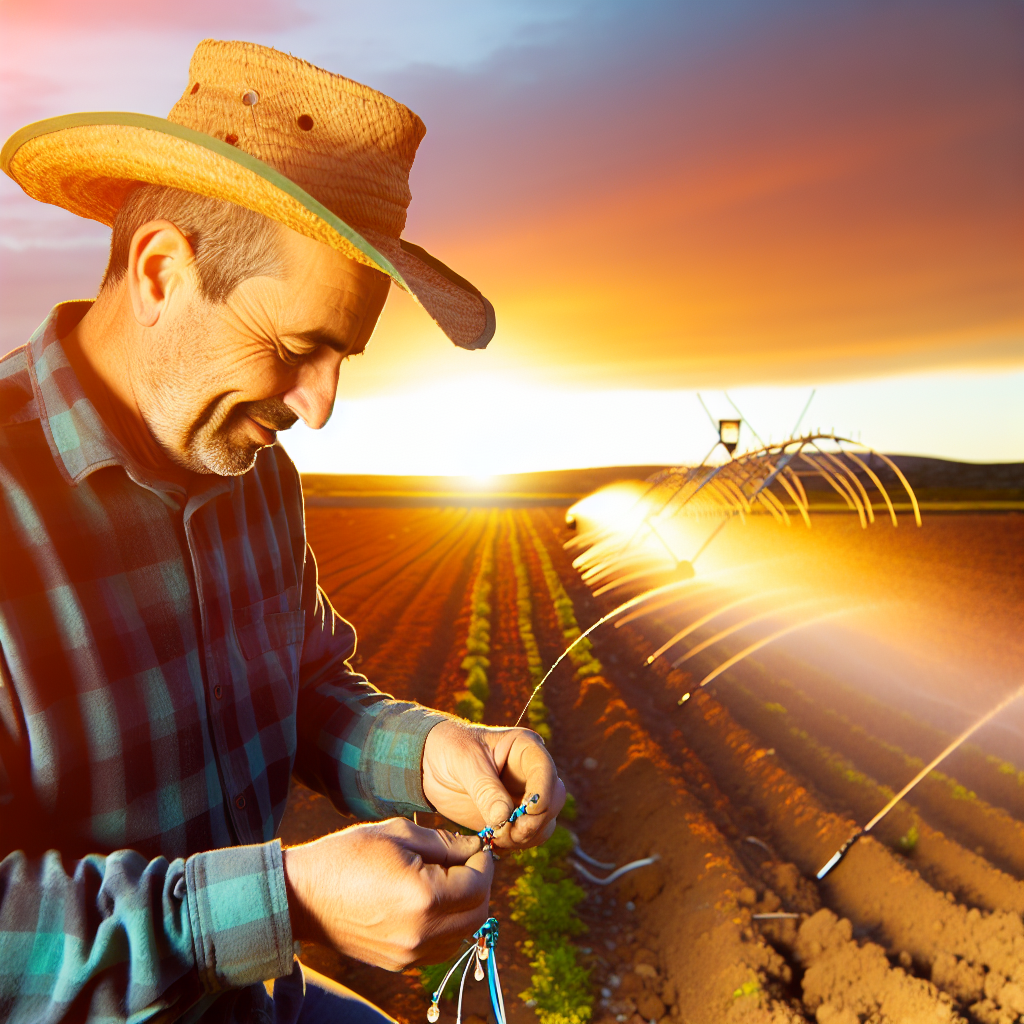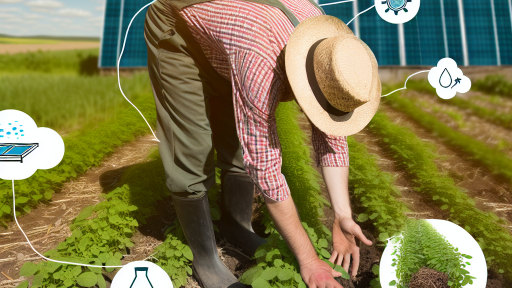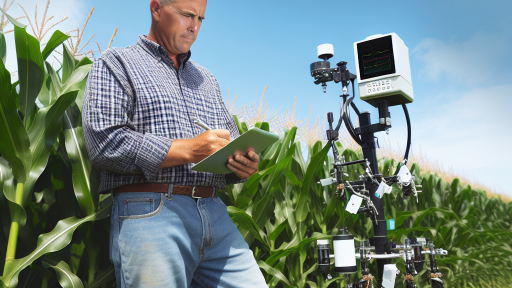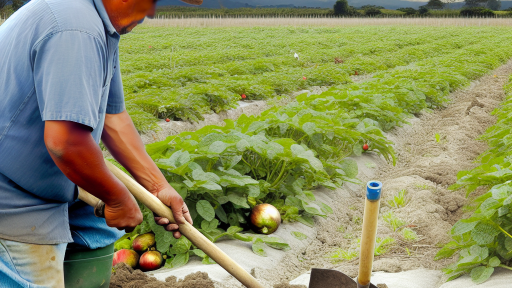Introduction to Climate Change and Its Impact on Agriculture
Climate change poses significant challenges to agriculture worldwide.
Rising temperatures disrupt traditional farming practices.
Furthermore, changing precipitation patterns threaten crop yields.
More extreme weather events increase risks for farmers.
Overall, these changes undermine food security and livelihoods.
Understanding Climate Change
Climate change results from human activities, primarily greenhouse gas emissions.
This leads to global warming and shifts in climatic conditions.
As a result, ecosystems face unprecedented stress.
Forests, rivers, and agricultural land all feel the pressure.
Effects on Crop Production
Crops depend heavily on stable climate conditions for optimal growth.
Temperature increases can lead to heat stress, reducing yields.
Drought can diminish water availability for irrigation.
In contrast, excessive rainfall can lead to flooding and soil erosion.
These extremes complicate crop management practices.
Impacts on Specific Crops
Different crops respond variably to climate-induced changes.
Transform Your Agribusiness
Unlock your farm's potential with expert advice tailored to your needs. Get actionable steps that drive real results.
Get StartedFor instance, wheat may struggle under higher temperatures.
On the other hand, rice often suffers from too much water.
Additionally, pests and diseases may thrive in warmer climates.
Socioeconomic Consequences
Farmers may experience reduced income due to declining yields.
Rural communities face heightened food insecurity.
As a result, migration might increase in search of better opportunities.
Moreover, local economies can suffer from decreased agricultural productivity.
Strategies for Adaptation
Farmers must adopt innovative practices to combat these challenges.
These strategies can enhance resilience against climate impacts.
For example, crop rotation can improve soil health.
Utilizing drought-resistant varieties can also be beneficial.
Implementing sustainable water management practices is crucial.
Understanding Climate Adaptation
Definitions and Importance
Climate adaptation refers to the adjustments made in practices, processes, and structures.
These adjustments help mitigate the effects of climate change.
Farmers play a crucial role in implementing these adaptations effectively.
Adapting to climate change ensures sustainable agricultural practices.
Moreover, it protects livelihoods against environmental impacts.
Farmers face challenges such as extreme weather events and changing seasons.
Understanding these challenges is vital for successful adaptation strategies.
The Need for Climate Adaptation
As climate patterns change, agricultural systems must respond accordingly.
Without adaptation, crop yields may significantly decline.
This decline threatens food security globally.
Furthermore, adaptation improves the resilience of farming systems.
Resilience allows farmers to recover from climate-related shocks.
Showcase Your Farming Business
Publish your professional farming services profile on our blog for a one-time fee of $200 and reach a dedicated audience of farmers and agribusiness owners.
Publish Your ProfileInvesting in climate adaptation also enhances economic stability for farmers.
Components of Climate Adaptation
Effective adaptation includes various strategies and practices.
- Diverse cropping systems help improve resilience.
- Soil health management enhances productivity.
- Irrigation efficiency reduces water use in dry conditions.
Additionally, agroforestry practices can buffer extreme weather.
These components work together to create a robust agricultural system.
Collaborative Approaches
Collaboration among farmers, scientists, and policy-makers is essential.
Sharing knowledge promotes effective adaptation techniques.
Community-based initiatives can also foster resilience.
Ultimately, a united effort leads to greater success in climate adaptation.
Key Climate Risks Facing Farmers
Droughts
Droughts pose a significant threat to agricultural productivity.
They lead to reduced crop yields and increased irrigation costs.
Farmers must adapt to cope with prolonged dry spells.
Mitigation strategies include selecting drought-resistant crops.
Additionally, implementing advanced irrigation techniques is essential.
Moreover, soil moisture management plays a critical role.
Floods
Flood risks can devastate farming operations and infrastructure.
Heavy rainfall and rising water levels disrupt planting and harvesting.
Farmers need effective drainage systems to prevent crop losses.
Planting cover crops can also help mitigate erosion from floods.
Establishing resilient soil structures enhances water absorption.
Extreme Weather
Extreme weather events have become more frequent and intense.
These include storms, heatwaves, and freezing temperatures.
Farmers must monitor weather patterns closely to protect their crops.
This can involve using technology for timely alerts on severe conditions.
Additionally, diversifying crops can reduce risk exposure.
Training and education on adapting to weather changes are crucial.
Learn More: Economic Strategies for Climate-Resilient Agricultural Practices
Tools and Technologies for Climate Monitoring and Forecasting
Importance of Accurate Climate Information
Accurate climate information is vital for effective farming.
It enables farmers to make informed decisions about their crops.
Additionally, it helps in planning for extreme weather events.
Key Technologies for Climate Monitoring
A range of technologies is available for climate monitoring.
These tools provide real-time data on weather conditions.
Drones are increasingly used for aerial observations.
Remote sensing satellites offer comprehensive coverage of agricultural areas.
Moreover, IoT devices collect data from the field directly.
Weather Stations
Weather stations are essential for localized data collection.
They measure temperature, humidity, and precipitation.
This information assists farmers in understanding microclimates.
Climate Modeling Software
Climate modeling software predicts future weather patterns.
Farmers can use these predictions to plan crop cycles.
Several models analyze parameters affecting agricultural productivity.
Showcase Your Farming Business
Publish your professional farming services profile on our blog for a one-time fee of $200 and reach a dedicated audience of farmers and agribusiness owners.
Publish Your ProfileForecasting Tools and Techniques
Forecasting tools enhance the ability to anticipate weather changes.
Using historical data, these tools predict future climate scenarios.
Farmers can access weather forecasts through various platforms.
Mobile Applications
Mobile applications provide farmers with timely weather updates.
Many apps also offer personalized agricultural advice.
Farmers can receive alerts for extreme weather events.
Online Platforms
Several online platforms aggregate climate data for farmers.
These platforms often include visualizations and analytics.
Farmers can explore trends and adjust their strategies accordingly.
Community Engagement in Climate Adaptation
Community engagement enhances the effectiveness of climate strategies.
Farmers benefit from knowledge sharing within their networks.
Workshops and training sessions foster collaboration and innovation.
Networking Opportunities
Joining local or regional farmer groups can lead to valuable insights.
Such networks also advocate for better climate policies.
Partnerships with Research Institutions
Collaborating with research institutions can boost farming practices.
These partnerships develop tailored strategies for local conditions.
They also facilitate access to cutting-edge technologies.
See Related Content: Adaptation Strategies for Farmers in Changing Climates
Soil Health Management as a Tool for Resilience
Importance of Soil Health
Healthy soil forms the foundation of sustainable agriculture.
It enhances productivity while minimizing resource use.
Moreover, healthy soil contributes to ecosystem stability.
Key Practices for Soil Health Management
Farmers can adopt various practices to improve soil health.
- Cover cropping prevents soil erosion and improves structure.
- Crop rotation enhances nutrient availability and pest control.
- Composting enriches soil with organic matter and beneficial microbes.
- Reduced tillage minimizes disruption and maintains soil integrity.
Benefits of Active Soil Management
Active management of soil promotes resilience against climate change.
It improves water retention, which aids drought resilience.
Additionally, healthy soils foster biodiversity and soil microorganisms.
This ultimately results in better crop yields and quality.
Monitoring Soil Health
Regular soil testing is vital for effective management.
Tests reveal nutrient levels and pH balance.
Farmers can adjust practices based on test results.
This approach leads to targeted interventions and resource efficiency.
Technological Innovations in Soil Management
Technology aids in the efficient monitoring of soil conditions.
For instance, sensors can track soil moisture and temperature.
Data analytics helps optimize fertilization and irrigation practices.
These advancements enhance overall farm productivity and resilience.
Explore Further: Innovative Water Recycling Methods in Agriculture

Water Conservation Techniques
Rainwater Harvesting
Rainwater harvesting collects and stores rainwater for agricultural use.
This method reduces dependency on traditional water sources.
Farmers can use various collection systems to implement it effectively.
For instance, rooftops can channel rainwater into storage tanks.
Moreover, selecting the right storage method is crucial for effectiveness.
Showcase Your Farming Business
Publish your professional farming services profile on our blog for a one-time fee of $200 and reach a dedicated audience of farmers and agribusiness owners.
Publish Your ProfileConsider using either cisterns or barrels based on available space.
Implementing filtration systems ensures collected water remains clean.
Additionally, maintenance of these systems is vital for longevity.
Regularly check for leaks to prevent water wastage.
With effective rainwater harvesting, farmers can enhance sustainability.
Irrigation Strategies
Efficient irrigation plays a significant role in water conservation.
Farmers can adopt techniques that minimize water loss.
For example, drip irrigation delivers water directly to plant roots.
This reduces evaporation and runoff significantly.
Another strategy involves the use of sprinklers with timers.
By monitoring soil moisture, farmers can tailor watering schedules.
This approach prevents overwatering and promotes healthy crops.
Additionally, mulching around plants retains soil moisture.
Farmers should regularly assess and adjust watering practices.
Ultimately, choosing the right irrigation technique increases yields.
Uncover the Details: Climate-Smart Farming: Essential Adaptation Strategies
Crop Selection and Diversification for Climate Resilience
Importance of Crop Diversity
Crop diversity enhances resilience against climate variability.
By planting a variety of crops, farmers can reduce risks.
Different crops may respond uniquely to changing weather patterns.
This strategy can lead to improved soil health.
Moreover, it supports beneficial insects and overall biodiversity.
Choosing Climate-Resilient Crops
Select crops that can withstand extreme weather conditions.
Consider varieties that are heat-resistant or drought-tolerant.
Evaluate local climate trends when making selections.
Consult with agricultural experts for tailored recommendations.
Furthermore, utilizing native plants can enhance resilience.
Implementing Crop Rotation
Crop rotation helps manage soil fertility and pests.
Changing crops in a regular pattern can prevent disease.
This method improves nutrient cycling in the soil.
Additionally, it reduces the risk of crop failure.
Farmers should plan their rotations with careful consideration.
Adopting Intercropping Practices
Intercropping involves growing two or more crops in proximity.
This technique maximizes space and resources efficiently.
It also enhances yields by promoting beneficial interactions.
For instance, pairing legumes with cereals boosts nitrogen levels.
Farmers can experiment with different combinations for best results.
Utilizing Cover Crops
Cover crops play a crucial role in soil conservation.
They help prevent erosion and maintain soil structure.
Moreover, cover crops can suppress weeds effectively.
Choosing the right cover crop depends on specific needs.
Showcase Your Farming Business
Publish your professional farming services profile on our blog for a one-time fee of $200 and reach a dedicated audience of farmers and agribusiness owners.
Publish Your ProfileFarmers should assess the benefits of various species.
Monitoring and Adapting Practices
Regular monitoring helps identify emerging challenges.
Farmers should keep records of weather patterns and performances.
Use technology such as apps to track crop health efficiently.
Based on findings, adjust farming practices as needed.
Embracing flexibility can result in better crop outcomes.
Community Engagement and Knowledge Sharing for Adaptive Strategies
The Importance of Community Involvement
Community involvement plays a crucial role in climate adaptation efforts.
Farmers greatly benefit from shared knowledge and resources.
Engaging local communities fosters collaboration and innovation.
Additionally, it helps identify specific local challenges.
Building Strong Networks
Creating strong networks enhances information flow among farmers.
These networks facilitate the sharing of best practices.
Furthermore, they allow farmers to support one another.
Local cooperatives can serve as effective platforms for networking.
Utilizing Technology for Information Sharing
Technology offers new ways for communities to connect.
Online forums and social media platforms are invaluable tools.
They enable farmers to share real-time updates and experiences.
Mobile applications can help in disseminating critical weather information.
Conducting Workshops and Training Sessions
Organizing workshops can enhance farmers’ adaptive strategies.
These sessions provide hands-on learning experiences.
Expert speakers can offer valuable insights on climate resilience.
Training sessions can also cover new sustainable practices.
Creating Resource Sharing Initiatives
Resource sharing among farmers can improve adaptation efforts.
Common tools and equipment can be shared to reduce costs.
Furthermore, shared resources amplify the impact of individual efforts.
This approach strengthens community ties and support systems.
Engaging with Local Governments and Organizations
Collaboration with local governments enhances community initiatives.
Governments can provide crucial resources and policy support.
Partnering with organizations can offer technical expertise.
These partnerships can lead to more effective adaptation strategies.
Encouraging Feedback and Continuous Improvement
Establishing channels for feedback is vital for success.
Farmers should feel empowered to share their experiences.
Constructive feedback helps refine adaptive strategies over time.
Regular evaluations can enhance the effectiveness of community efforts.




